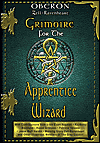
Grimoires (magical handbooks) are said to have been traditionally created and used by magical practitioners throughout the ages. Packed with magical lore and practical information on issues like what magic and power really are and how people can lead ethical as well as magical lives, this is a 21st century grimoire. It is, in fact, aimed at the kids (mostly boys, as girls seldom refer to themselves as wizards) who’ve read Harry Potter and Lord of the Rings or have begun wondering what the world is really all about. Because this grimoire does not contain get-a-boyfriend spells or spells to overcome your enemies, it’s an excellent alternative to the popular “teen witch” books. With its emphasis on the nature of magic—and on magical Mother Nature and the four elements—the book might also be a welcome anodyne to teenage testosterone, addiction to video games, gangs, and the so-called urban culture. But it may never, alas, reach all of the young readers who would benefit from its wisdom, partly because hip-hop kids don’t read and partly because the implicit audience is white teenage boys. Most of the lore is European and the famous wizards of history are nearly all white men.
Nevertheless, this is a book of everything you ever wanted to know about magick but didn’t know who to ask. There are theory and history (but not so much that the reader is ever bored) and lots of opportunities to practice what you’ve just read about. There is, for example, a glossary of magical practitioners—wizard, visier, mage, sage, mystic, druid, bard, magician, alchemist, sorcerer, etc., and the important distinction between wizard and sorcerer is given several times. “The primary distinction,” Oberon writes, “lies in the realm of service. A Wizard desires to be service to others; a Sorcerer desires to be served by others” (p. 26, emphasis in the original).The Rules of Magick and Wizardry begin with “magick is real” and “know thyself” and include “question authority” (later in the book, “authority” is defined not only as someone in charge but also someone who knows things), “be watchful of what you do and say,” and “the job isn’t done until you’ve put away the tools and cleaned up the mess.” These are lessons even grown-ups too seldom understand.
Some people say that magic arises from the devil. This can make Wiccans and other magical practitioners defensive, so they distinguish between “white” magic and “black” magic. As Isaac Bonewits did in Real Magic (originally published in the early 1970s), Oberon lists the true colors of magic: aqua (meditation), blue (healing), green (wortcunning, or herbal magic), yellow (divination), orange (illusion or stage magic), red (alchemy), brown (beast mastery, or working with animals), violet (cosmology and the stars), clear (“mathemagicks,” or numerology), white (ceremonial magic), grey (mastery of magical lore, or teachings, including myth and legend and the wisdom of the ages), and black (the “dark arts”).
The curriculum given in the grimoire is divided into seven “courses” of magical lore: Wizardry, Nature, Practice, Rites, Spectrum (Parts 1 and 2), and Lore, plus appendices. Each course is divided into six or seven classes and each class contains a number of lessons. The book is illustrated throughout with nifty drawings and examples from Oberon’s own life. Unlike some books about gods or goddesses, however, this is not a book of Wiccan religion; its focus is strictly on the practical aspects of the magical life.
Parents, buy this book for your son or daughter. Read it along with them (or when they’re asleep) so you’ll know as much as they do. If enough kids apprentice themselves to the good Grey Council, we can have genuine hope for the future of the planet.
~review by Barbara Ardinger, Ph.D.
Author: Oberon Zell-Ravenheart and the Grey Council
New Page Books, 2004
